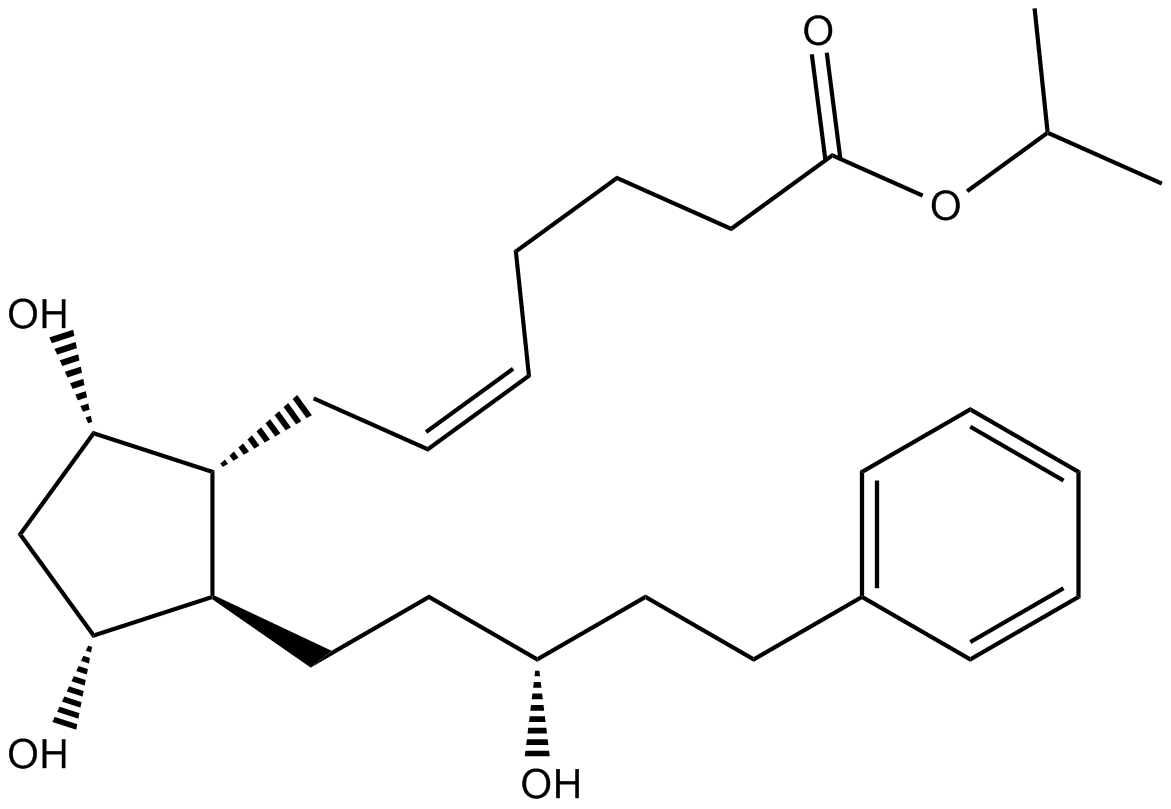Latanoprost (Synonyms: CAY530500, 17phenyl13,14dihydro trinor PGF2α isopropyl ester, 17phenyl13,14dihydro trinor Prostaglandin F2α isopropyl ester) |
| Catalog No.GC14004 |
Le latanoprost (PHXA41) est un analogue de la prostaglandine F2α et un agoniste du récepteur prostanoÏde FP, et abaisse la pression intraoculaire (PIO).
Products are for research use only. Not for human use. We do not sell to patients.

Cas No.: 130209-82-4
Sample solution is provided at 25 µL, 10mM.
Latanoprost (PHXA41) is a prostaglandin F2α analogue and an agonist for the FP prostanoid receptor, and lowers intraocular-pressure (IOP).
Benzalkonium chloride latanoprost (BAK-latanoprost) and 0.02% BAK induce significant apoptosis in the apical layers that correlated with the significant decrease of cell viability. Preservative-free latanoprost (PF-latanoprost) slightly decreases cell viability and few apoptotic cells are found in the superficial layers, without reaching statistical significance compared with PBS[1]. Latanoprost (0.1 μM) significantly increases cell viability as compared with control. Meanwhile, 0.1 μM latanoprost results in the obvious promotion of neurite outgrowth similar to ciliary neurotrophic factor (CNTF) and simultaneously increases the levels of p-Akt and p-mTOR expression. Latanoprost can promote neurite outgrowth through an FP receptor-mediated modulation of the PI3K-Akt-mTOR signaling pathway[3]. Latanoprost (0.03 or 0.3 μg/mL) and bimatoprost increase MMP-9 activity by 75% ± 27% and 75% ± 24%, respectively, in human CBSM cells[4].
A single drop of latanoprost results in marked miosis, anterior bowing of the peripheral iris, narrowing of the iridocorneal angle, and shallowing of the anterior chamber of the beagle dog. Following latanoprost, the pupil diameter, ACA, and AOD (means) decreases 84%, 14%, and 16%, respectively[2].
References:
[1]. Pauly A, et al. In vitro and in vivo comparative toxicological study of a new preservative-free latanoprost formulation. Invest Ophthalmol Vis Sci. 2012 Dec 13;53(13):8172-80.
[2]. Zheng J, et al. Latanoprost promotes neurite outgrowth in differentiated RGC-5 cells via the PI3K-Akt-mTOR signaling pathway. Cell Mol Neurobiol. 2011 May;31(4):597-604.
[3]. Tsai S, et al. The effect of topical latanoprost on anterior segment anatomic relationships in normal dogs. Vet Ophthalmol. 2013 Sep;16(5):370-6.
[4]. Ooi YH, et al. Effect of bimatoprost, latanoprost, and unoprostone on matrix metalloproteinases and their inhibitors in human ciliary body smooth muscle cells. Invest Ophthalmol Vis Sci. 2009 Nov;50(11):5259-65.
[5]. B'Ann True Gabelt, et al. Prostaglandin Subtype-Selective and Non-Selective IOP-Lowering Comparison in Monkeys.
Average Rating: 5 (Based on Reviews and 9 reference(s) in Google Scholar.)
GLPBIO products are for RESEARCH USE ONLY. Please make sure your review or question is research based.
Required fields are marked with *




















